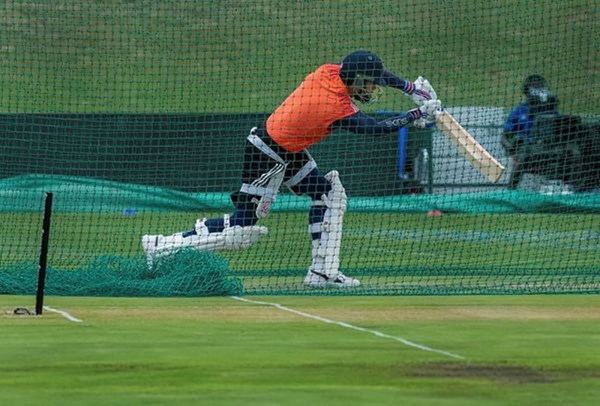‘One full-hand of extra bounce, got to leave well’: Faf du Plessis details the batting mantra for success for India in South Africa Test series
Faf du Plessis is prompt and to the point when one asks him what makes South African conditions the most challenging for Indian batsmen.
“It’s the bounce,” he ascertains. Since South Africa’s readmission, this is India’s ninth Test tour of the Rainbow nation, the only country where they are still chasing a series win in red-ball cricket, with their first win in the format coming only in 2006. Since then in four trips to South Africa, they have had only three wins in 11 Tests.

Behind many a broken dream there lies a pattern, of how India’s batsmen have crumbled when exposed to high pace, bounce and seam movement on juicy pitches.
Since 2010, no country has tested India’s current crop of batsmen as much as South Africa does. In Australia where they have won successive Test series against the most fearsome pace trio going around in the last decade, Indian batsmen have averaged 31.06 collectively. Even in England where the conditions have been loaded in favour of seamers, they average 27.25. And in New Zealand, where they hardly get any time to acclimatise sans practice games, their average stands at 30.96. But it is in South Africa that their average comes down to 25.02.
 Indian player Virat Kohli bats during a practice session ahead of the first Test cricket match between India and South Africa, in Gauteng, South Africa, Sunday, Dec. 24, 2023. (PTI Photo)
Indian player Virat Kohli bats during a practice session ahead of the first Test cricket match between India and South Africa, in Gauteng, South Africa, Sunday, Dec. 24, 2023. (PTI Photo)
“It is the bounce,” du Plessis reiterates to The Indian Express as to why Indian batsmen find it all the more challenging. “There is almost one full hand of extra bounce here, compared to what they usually face in India. They are used to hitting the ball on the up there, but with the bounce on offer and lateral movement, there is additional risk at play if you haven’t done it before and are not used to the lift. The key to doing well in South Africa is to leave well and be there for a long period,” the former Proteas captain adds.
The ‘leaving the ball’ bit that Du Plessis mentions is similar to what batsmen are told to do in England, where the ball seams around the whole day. South Africa, thanks to the lateral and seam movement that the conditions offer is similar, which keeps bowlers in the game right through. It is what South Africa batsmen do exceedingly well, especially the likes of Dean Elgar, as they don’t commit to a shot till the last moment. Even if they were to leave the ball, they delay it to the point where they can’t wait any longer, trusting the bounce on offer, especially in the first and second innings.
Result-oriented pitch
Centurion, the venue for the first Test starting on Tuesday, is known to be a tricky pitch. It is a venue where the ball tends to seam around throughout and gets quicker as the Test progresses. So despite rain being a forecast for the first day, there is still a definite chance of the pitch producing a result. “Generally on Day 1, there’s a bit of grass on the wicket, it’s a bit slow. So it seams around a little bit. Then day two and three are really good batting surfaces. But then again, it speeds up really quickly, and the cracks on the pitch start to get bigger with the bit of heat in the pitch. And then towards the end of day four and day five, there will be up and down bounce. So if you bat well in the first innings, it is always difficult to lose a Test in Centurion. But if you fail with the bat in the first innings, you are in for a long battle,” Du Plessis explains.
 Indian captain Rohit Sharma bats during a practice session ahead of the first Test cricket match between India and South Africa, in Gauteng, South Africa, Sunday, Dec. 24, 2023. (PTI Photo)
Indian captain Rohit Sharma bats during a practice session ahead of the first Test cricket match between India and South Africa, in Gauteng, South Africa, Sunday, Dec. 24, 2023. (PTI Photo)
On such pitches, with patience being a virtue, India have drifted off that plan a bit. Instead, they have tried to be a lot more positive in terms of going for the runs, with then captain Virat Kohli even demanding that batsmen show more intent, even dropping Ajinkya Rahane in 2018 for Rohit Sharma – who was still not the Test batsman he is now. And among SENA (South Africa, England, New Zealand, Australia) countries, despite their average being the lowest in South Africa, the 3.12 runs per over they have scored here since 2010 is their second-fastest.
“I remember the 2018 series, where they ran us close. They left the ball really well then and that is the key to be a successful Test side in South Africa. You have got to be patient and respect the conditions at all times. You need to have a good plan as to how you play the short balls with the extra bounce and how well you leave them. And in South Africa, I’ve noticed more than the ones who attack you with short balls, it is the ones who trouble you with movement and constantly target the top of off-stump who chip away with wickets. So you need to be patient in seeing off those spells,” Du Plessis argues.
Runs priceless
With both India and South Africa evenly matched in terms of bowling resources, Du Plessis reckons it will come down to which batting unit handles the pressure better. Last time, despite losing the first Test, the hosts turned the tables in the next two, with their batsmen showing better application than India. “Runs will be gold. When you have runs on the board, you will invariably have a good chance of winning. India obviously have a lot more experience than South Africa and they are a dangerous Test side. If they manage some runs, the bowlers can work around it,” Du Plessis says.
The series defeat in 2021 would have stung India. Having gone there with high hopes of a series win, especially on the back of having a team that had done exceedingly well in Australia and South Africa, they were blown away in successive Tests after taking the series lead. It seemed as if India would have to wait a few more years to redeem itself. But, thanks to the World Test Championship Future Tours Programme, they now get another opportunity. Centurion. Boxing Day. #BringItOn
Disclaimer: The copyright of this article belongs to the original author. Reposting this article is solely for the purpose of information dissemination and does not constitute any investment advice. If there is any infringement, please contact us immediately. We will make corrections or deletions as necessary. Thank you.





